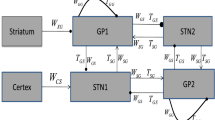Abstract
The persistence of beta oscillations generated in the basal ganglia is typical pathological characteristic of Parkin-son’s disease. In this paper, we construct a new network model, which is mainly composed of the subthalamic nu-cleus and the globus pallidus. Based on theory analysis, we obtained the beta shock conditions in the proposed model. It is shown that numerical simulations are in good agreement with analytical results. At last, the effects of cortex and striatum inputs on the generation of oscillations are also discussed. We hope that the obtained results may find applications to treatment of Parkinson’s disease and study of neural oscillations produced in other parts of the brain neural network.
Similar content being viewed by others
References
Lau L, Breteler M. Epidemiology of Parkinson disease. Neurology, 2006, 5: 1362–1369
Bernheimer H, Birkmayer W, Hornykiewicz O, et al. Brain dopamine and the syndromes of Parkinson and Huntington. J Neurol Soc, 1973, 20: 415–455
Ehringer H, Hornykiewicz O. Verteilung von Noradrenalin und Dopamin (3-Hydroxytyramin) im Gehirn des Menschen und ihr Verhalten bei Erkrankungen des extrapyramidalen Systems. Klin Wschr, 1960, 38: 1236–1239
Uhl G, Hedreen J, Price D. Loss of neurons from the ventral tegmental area contralateral to therapeutic surgical lesions. Neurology, 1985, 35: 1215–1218
Jankovic J. Parkinson’s disease: Clinical features and diagnosis. J Neurol Neurosurg Psychiatry, 2008, 79: 368–376
Boraud T, Brown P, Goldberg J A, et al. Oscillations in the basal ganglia: The good, the bad, and the unexpected. In: Advances in behavioral biology, The basal ganglia VIII. Bolam J P, Ingham C A, Magill P J, eds. New York: Springer, 2005, 56: 1–24
Mark D, Humphries, Kevin G. Network effects of subthalamic deep brain stimulation drive a unique mixture of responses in basal ganglia output. Eur J Neurosci, 2012, 36: 2240–2251
Jean-Michel D, Bertrand D, Cle’mentine B, et al. Deep brain stimulation mechanisms: Beyond the concept of local fun-ctional inhibition. Eur J Neurosci, 2010, 32: 1080–1091
Nevado H A, Terry J, Bogacz R. Conditions for the generation of beta oscillations in the subthalamic nucleus-globus pallidus network. J Neurosci, 2010, 30: 12340–12352
Alex P S, John H, Rafal B. Improved conditions for the generation of beta oscillations in the subthalamic nucleus-globus pallidus network. Eur J Neurosci, 2012, 36: 2229–2239
Guo S, Zhuang P, Mark H, et al. Subthalamic deep brain stimulation for Parkinson’s disease: Correlation between locations of oscillatory activity and optimal site of stimulation. Parkinsonism Related Disorders, 2013, 19: 109–114
Park C, Rubchinsky Leonid L. Potential mechanisms for imperfect synchronization in Parkinsonian basal ganglia. Plos One, 2012, 7: e51530
Mallet N, Pogosyan A, Marton L F, et al. Parkinsonian beta oscillations in the external globus pallidus and their relationship with subthalamic nucleus activity. J Neurosci, 2008, 28: 14245–14258
Mallet N, Pogosyan A, Sharott A, et al. Disrupted dopamine transmission and the emergence of exaggerated beta oscillations in subthalamic nucleus and cerebral cortex. J Neurosci, 2008, 28: 4795–4806
Kuhn A A, Tsui A, Aziz T, et al. Pathological synchronisation in the subthalamic nucleus of patients with Parkinson’s disease relates to both bradykinesia and rigidity. Exp Neurol, 2009, 215: 380–387
Hammond C, Bergman H, Brown P. Pathological synchronization in Parkinson’s disease: Networks, models and treatments. Trends Neurosci, 2007, 30: 357–364
Eusebio A, Brown P. Synchronisation in the beta frequency-band-the bad boy of parkinsonism or an innocent bystander. Exp Neurol, 2009, 217: 1–3
Gillies A, Willshaw D. Neuroinformatics and modeling of the basal ganglia: bridging pharmacology and physiology. Expert Rev Med Devices, 2007, 4: 663–672
van Albada S J, Robinson P A. Mean-field modeling of the basal ganglia-thalamocortical system. I: Firing rates in healthy and Parkinsonian states. J Theor Biol, 2009, 257: 642–663
Frank M J. Hold your horses: A dynamic computational role for the subthalamic nucleus in decision making. Neural Netw, 2006, 19: 1120–1136
Leblois A, Boraud T, Meissner W, et al. Competition between feedback loops underlies normal and pathological dynamics in the basal ganglia. J Neurosci, 2006, 26: 3567–3583
Vogels T, Rajan K, Abbott L. Neural network dynamics. Annu Rev Neurosci, 2005, 28: 357–376
Asl F, Ulsoy A. Analysis of a system of linear delay differential equations. J Dyn Syst Meas Contr, 2003, 125: 215
Author information
Authors and Affiliations
Corresponding author
Rights and permissions
About this article
Cite this article
Hu, B., Wang, Q. The conditions for onset of beta oscillations in an extended subthalamic nucleus-globus pallidus network. Sci. China Technol. Sci. 57, 2020–2027 (2014). https://doi.org/10.1007/s11431-014-5653-7
Received:
Accepted:
Published:
Issue Date:
DOI: https://doi.org/10.1007/s11431-014-5653-7




